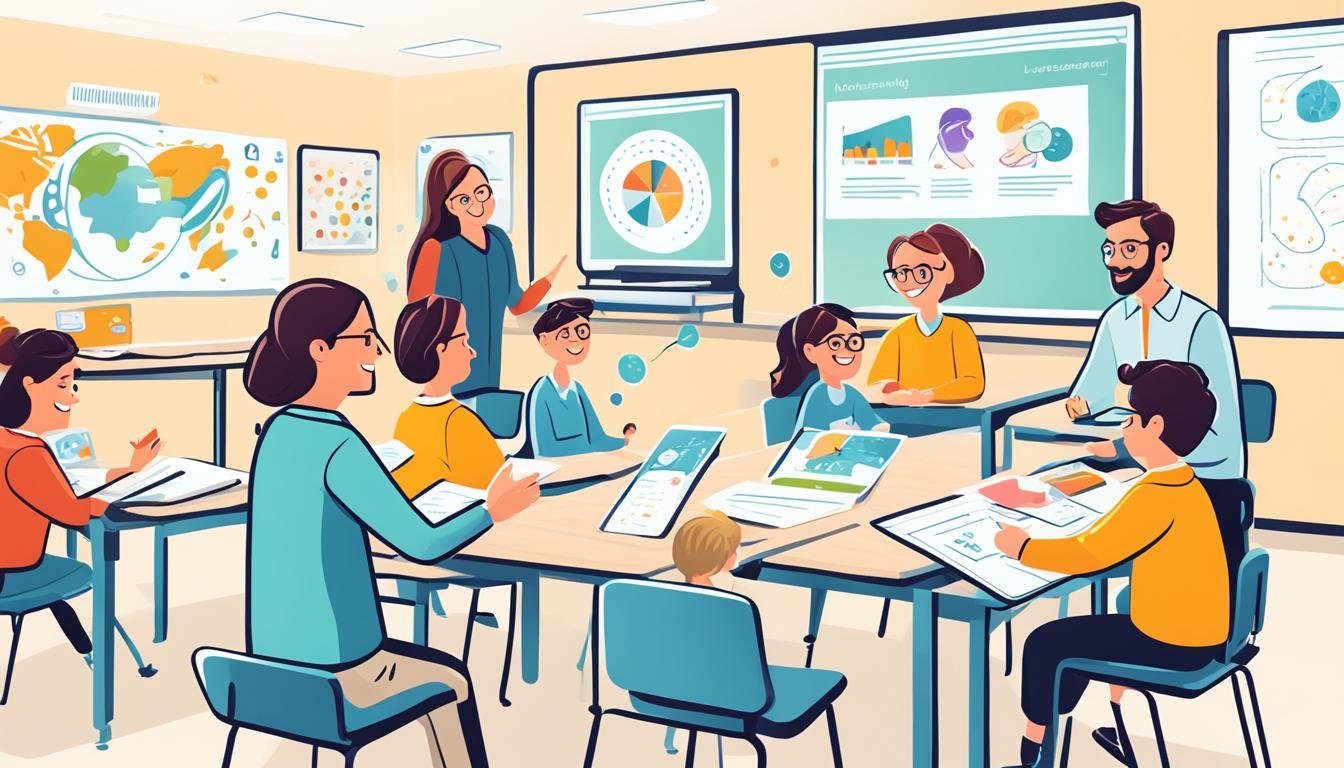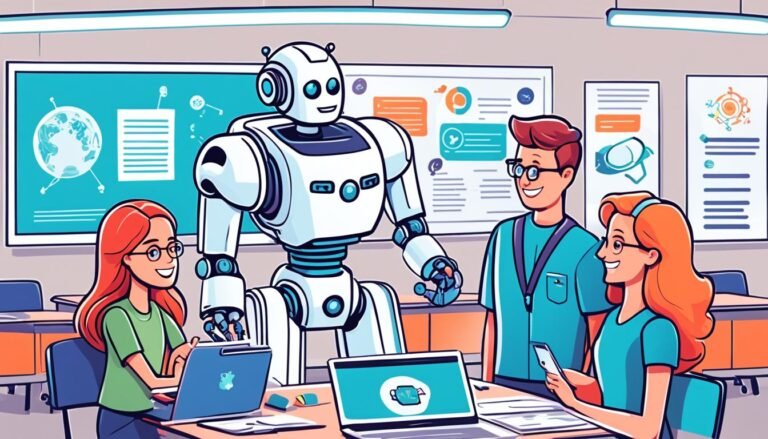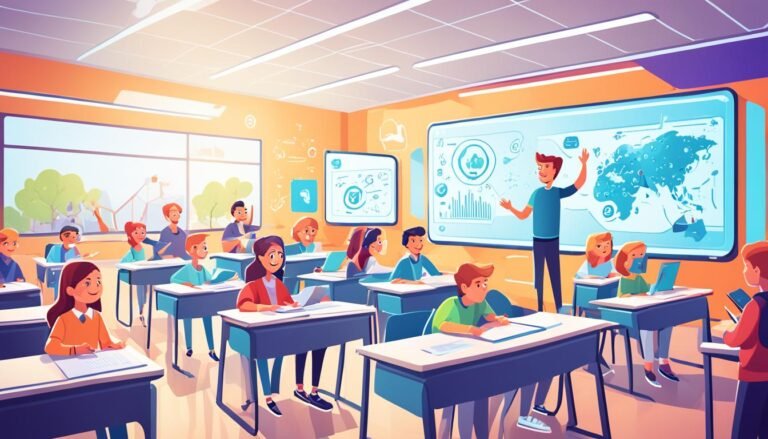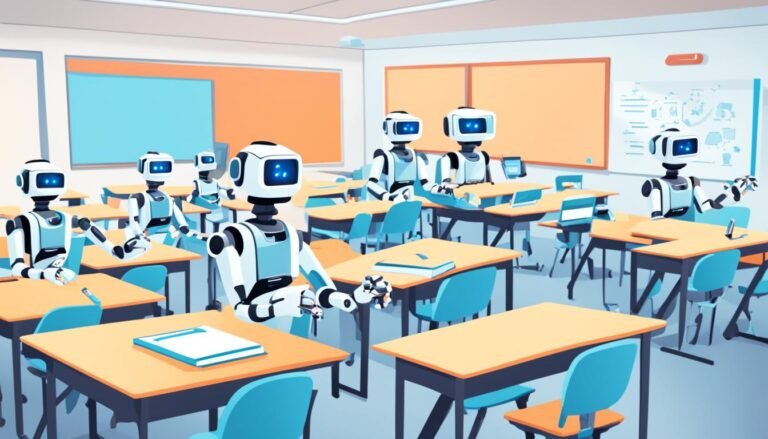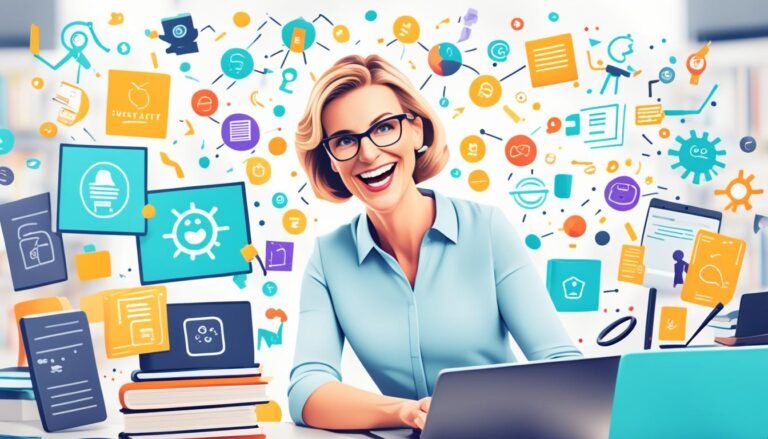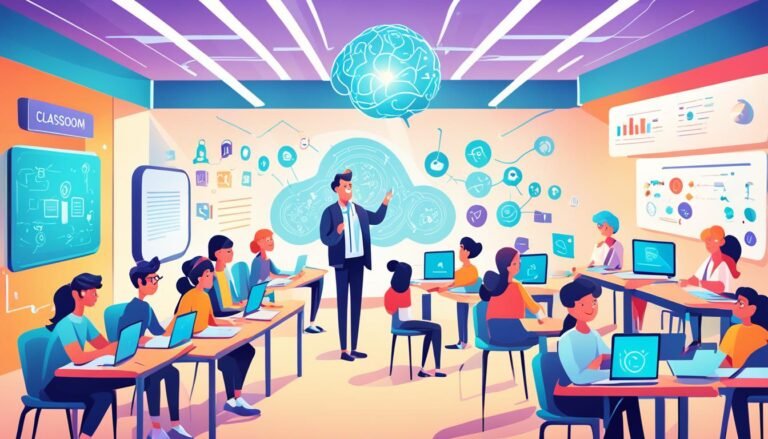AI in Special Education: Transforming Learning
Imagine a classroom where every student’s unique needs are met with care. In 2013, a British primary school debuted a small humanoid robot called NAO. It made a big difference by aiding children with Autism Spectrum Disorder (ASD) in improving their speech. NAO didn’t tire or lose patience, traits important for all students. This example shows how a mix of compassionate teaching and advanced tech is changing lives.
Artificial Intelligence (AI) in Special Education is a game-changer. It blends AI and cutting-edge classroom tech to revolutionize education for all. Though AI has been around for 50 years, its influence on accessible educational tools and personalized learning is now clearly seen.
AI helps classrooms become adaptable learning spaces. It tailors lessons to each child’s pace and needs, making learning more fun and efficient. Whether it’s AI tutoring systems that provide personal lessons or tech that aids student communication, AI offers a wide array of advantages.
The use of AI in education began with simpler tasks like grading and scheduling. Now, however, it is focusing more on the student, revealing its true power. AI’s data analytics can follow student progress, predict results, and offer tips to improve. This helps both students and teachers.
Key Takeaways
- AI has been in development for about 50 years and is now starting to be used in classrooms and other areas.
- AI can increase accessibility and support a student’s independence in the special education classroom.
- AI can help support various learning outcomes for students with and without disabilities.
- Purposeful and meaningful use of AI can drive change for learners.
- AI has the potential to tailor learning experiences and make them more personalized.
Introduction to AI in Special Education
Special education helps students with various learning challenges. These challenges can be due to physical, mental, emotional, and developmental disabilities. Often, there’s a lack of resources like trained staff, funds, and tools for assistance. AI in education is changing this by offering new, helpful solutions.
What is AI?
AI, or Artificial Intelligence, is like human intelligence but in computer systems. It involves learning, thinking, and improving actions. In education, AI is making personal learning better. Now, teachers can meet the unique needs of every child, especially in special education, with AI systems.
The Evolution of AI in Education
AI’s journey in education began a long time ago, in the 1960s and 1970s. Back then, it was used for basic tasks. As technology grew, so did AI. Now, AI helps make learning adaptive and personal. It can customize what every student learns and give instant feedback. This helps both students and teachers.
Today, AI is changing how students with disabilities learn. For instance, tools like speech-to-text and communication devices are a big help. AI tools offer custom learning experiences, based on each student’s needs. They keep track of progress and provide insights, which is great for special education.
Adding AI to special education has other benefits too. It can help teachers with tasks like grading and lesson plans. UNESCO lays out how to use AI in education fairly. Their guidelines make sure AI helps all students equally, without making educational gaps worse.
The Need for AI in Special Education
Special education might not always meet the diverse needs of its students. As more kids with unique needs join schools, it’s harder to give them the help they need. Here, AI in Special Education steps in. It offers new AI-powered solutions to change how we teach.
Challenges in traditional special education
Old ways of teaching special ed have big issues. Educators spend lots of time making lessons simple for kids. Making sure they learn the same as others takes forever for teachers.
And there’s the snarl of writing IEPs. With AI, this is faster, saving 30 minutes per IEP. However, not many schools use AI for this work.
The promise of AI solutions
AI is a light at the end of the tunnel. It brings the hope of teaching each student better and more personally. It can even twist words to match any reading level, helping kids understand better. For those with autism, social stories are easier to make with AI. Canva also helps to make ideas clearer for students in special ed.
AI adjusts to how each student learns. Its benefits are many for special ed teachers. They can use their time better, helping every student. AI is also new in supporting better communication for these students.
Below is a table with important stats on AI in special education:
| Statistics | Details |
|---|---|
| Schools using AI tools | 16% of principals and district leaders |
| IEP writing efficiency | AI tools save up to 30 minutes per IEP |
| Grants for AI projects | Project received a $9,000 grant from CEC |
| AI adoption initiatives | Four webinars and award competition for educators |
| Educational tech alliances | CIDDL Tech Alliance includes multiple institutions |
AI in special education makes learning better and more fun for all students. It helps every child reach their full potential.
Personalized Learning Through AI
AI offers personalized learning that fits each student’s abilities and choices. It uses special algorithms to understand how a student learns. This helps make learning more interesting and effective. Students get instant feedback, which makes learning more dynamic. They can move forward at their own speed and level.
Benefits of tailored educational experiences
Special education has seen a big boost from AI. It looks at how each student learns and makes a plan just for them. For kids with disabilities, this means getting an education that meets their special needs. Adaptive assessments make sure they’re tested fairly, based on what they know. Plus, AI can make reading materials easier for kids with dyslexia to understand.
Case studies in personalized learning
Many studies have shown gains from using AI in education. AI keeps an eye on each student’s growth and changes their learning plan when needed. Schools in over 40 U.S. states are using this technology with good results. Also, AI combined with virtual and augmented reality makes learning more fun, especially for those with special needs.
AI has also upgraded how students with disabilities can communicate and learn. These tools learn how a child moves, looks, and talks to understand them better. They can even sense a child’s feelings by their face and voice. This helps kids learn to handle their emotions better.
| AI Feature | Benefit | Example |
|---|---|---|
| Adaptive Algorithms | Individualized Learning Plans | Tracking student progress and adjusting plans |
| Adaptive Assessments | Fair and Accurate Evaluation | Customized testing based on abilities |
| Personalized Learning Paths | Better Learning Outcomes | Tailored content for students with disabilities |
Role of Assistive Technology in Special Education
Assistive technology in special education helps students with disabilities. It uses artificial intelligence to improve learning. This makes learning better and easier.
Speech recognition technology is a good example of this help. It lets those with speech issues talk better. It fills in communication gaps. This leads to higher confidence and better learning.
Natural language processing makes tools smarter. They can understand and talk with you better. This ability makes the tools fit your needs more, making learning better.
Here are some key AI tools in special education:
| Technology | Function |
|---|---|
| Speech-recognition programs | Transcribes spoken words into written text |
| Optical character recognition (OCR) | Scans and reads printed material aloud |
| Electronic math worksheets | Aids in organizing and solving math problems |
| Talking calculators | Reads aloud numbers, symbols, and operations |
| Recorded books | Available in audiocassettes, CDs, and MP3 formats |
Institutions and lawmakers now back AI solutions in special education. They see how these tools can change education. They provide money and support laws to help get these tools to students.
Also, AI helps choose the best technology for each student. It looks at what the student needs and likes. This way, the tools keep helping as the student grows. They make learning more deep and personal.
Enhancing Accessibility with AI
AI-powered technologies have brought a new age of inclusive education. They make sure all students, no matter their abilities, do well. Tools like text-to-speech and speech-to-text help create fairer learning spaces.
Text-to-Speech and Speech-to-Text Technologies
Text-to-speech lets students with sight issues listen to written words. This opens up learning materials for them. Speech-to-text tech helps those who find writing hard. They speak their ideas, then it turns into text. These tools give disabled students more independent learning. They also improve how all students interact with lessons.
Breaking Down Communication Barriers
Augmentative and alternative communication tools are vital for inclusive education. They allow students who can’t speak well to convey their thoughts. This makes classrooms more open. Here, every student’s input is valued.
Online assignments and assessments are becoming more common. They are a big step for accessibility. Now, students who can’t be in class can join online. This change shows how AI can truly change learning. AI also tells teachers how to improve teaching based on each student’s needs. This makes learning fair for all.
AI in Speech and Language Therapy
AI helps students with speaking and language problems. It uses special programs to give them exercises and feedback. This improves how well they can talk and understand.
Timlogo is a top AI tool. It’s used by many speech therapists and in schools across the country. It shows how AI can help students practice alone but still get better every day.
AI is very important in helping these students all over the world. In the U.S., for example, 8% of kids have trouble speaking and 4% have big language issues. This costs a lot of money for their care. In other places like Central and Eastern Europe, many kids with disabilities can’t get a good education. This often happens because of speaking and language problems.
Starting help early is really important for these kids. Sadly, most of them don’t get the help they need. But, AI can check their problems quickly and accurately. This helps start the right treatment fast.
AI is creating new ways to help kids with different needs. For example, Apple made “Saylists” to help kids that have trouble with sounds. Then, there’s Huni, an app just for kids that need help talking. These tools make learning fun and interactive.
AI also helps the therapists work better. It makes making learning materials easier and faster. This means more time for working directly with the kids. Therapy can be made just for each child’s needs. It also makes helping kids more fun and new for the therapists. They can even make money with their own websites or apps.
The future for helping these kids is looking very good with AI. It keeps getting better and offers new ways to help. This means better care for all kids with speaking and understanding problems.
Augmentative and Alternative Communication Tools
Augmentative and Alternative Communication (AAC) tools, with the help of AI, have changed the game. They give a voice to non-verbal students. This means they can now express themselves.
Advances in communication for non-verbal students
Thanks to AI like OpenAI’s ChatGPT and Jasper AI, talking without words is easier. Now, students can chat using symbols, text, or voice outputs. It makes talking smoother and more personal.
This tech makes talking quicker and more exact for students. They can join in more conversations, ending old barriers. AI adjusts to how each person talks, which is super useful. And it only gets better as researchers fine-tune these tools based on user feedback.
Real-world applications and success stories
Examples of AI in AAC tools show big changes are happening. A lab by Elizabeth Lorah and Christine Holyfield is a key player. Funded by the National Science Foundation, it created new ways for non-verbal students to communicate.
These AI devices help people with autism, Down syndrome, and others to speak. By selecting words on a tablet, they can chat more easily. This boosts how they fit in and how independent they feel. Their stories also show how they can get creative and organized thanks to these tools. This proves how tech can make real differences in people’s lives.
In short, mixing AAC with AI is a big step towards a more inclusive world. These new tools are more like life-changers than just tech. They truly make life better for those who use them.
AI in Behavioral Therapy
AI is changing how we do behavioral therapy, especially for students with disabilities. In Hong Kong, AI tools have become key in helping kids with Special Education Needs (SEN). The number of these students has more than doubled in the past ten years.
Bridge AI in Hong Kong is leading with its system for individual learning. It tracks how well students do and suggests special plans for each one. This helps therapists better handle their workloads and connect more deeply with their students. This is crucial, as most disabled students in places that are still developing don’t have access to well-trained teachers.
Lenovo has teamed up with Bridge AI to boost AI use in therapies. They have taught AI to understand things like gestures and voices. This makes Bridge AI’s tools even better for helping SEN students learn. Lenovo is also helping businesses figure out how to use AI effectively. They are making AI ideas come to life.
One big way we use AI in behavioral therapy is with ABA therapy, known to help with autism and other disorders. AI makes things like data collection and monitoring behavior easier and less likely to have mistakes. Doing these tasks by video cuts down on time delays. We can then quickly help when a student needs it most.
Now, AI also helps with wearable devices that track how students are doing. These devices, combined with things like IoT, improve our understanding of behavior. Projects using AI, like DE-ENIGMA for autism, show the bright future of AI here. By analyzing a lot of data, AI can help spot problems early and plan personal treatments better. It helps figure out the best ways to use resources.
This chart shows how AI changes behavioral therapy:
| Aspect | Traditional Methods | With AI Integration |
|---|---|---|
| Data Collection | Manual and prone to human error | Automated with high accuracy |
| Behavior Monitoring | Labor-intensive and less frequent | Continuous and real-time |
| Feedback Response | Delayed and sporadic | Instant and consistent |
| Resource Allocation | General and less targeted | Personalized and efficient |
Adaptive Curriculum Development
Adaptive curriculum development uses AI to make learning modules that suit everyone’s style. The National Center for Special Education Research (NCSER) joined with the National Science Foundation in 2023. They started AI4ExceptionalEd to make special education better using AI. Researchers from nine US universities are working on this. They aim to use AI to solve different educational problems.
Creating Adaptable Learning Modules
AI in curriculum design makes sure each student gets the right help. The AI4ExceptionalEd team is using AI to change maths problems in the MATHia program. This helps students understand better. They tested this with 116,000 students and saw big improvements, especially for those with disabilities. This shows AI can make learning better for everyone.
Monitoring Progress and Adaptivity
AI is great for keeping track of how students are doing. It helps teachers change the curriculum so each student learns best. Real-time feedback and data analytics make learning more personal.
AI can spot areas where students need help and step in early. This keeps support going and helps everyone to reach their goals. This way, learning becomes more inclusive and supports every student’s journey.
Source Links
- AI in Special Education
- Exploring the Role of AI in Special Education – Best Online School in US
- Artificial Intelligence in Special Education | frog, part of Capgemini Invent
- The Role of Artificial Intelligence in Transforming Special Education – Home
- Inclusive Intelligence: The Impact of AI on Education for All Learners – CIDDL
- AI for Personalized Education: Revolutionizing Learning for Special Needs Individuals
- The Pros and Cons of AI in Special Education
- Leveraging AI in special education
- UMaine faculty investigating best uses for AI in special education – UMaine News – University of Maine
- AI in Special Needs Education: Personalized Support for Every Child
- AI and Special Education: Personalized Support for Diverse Learners
- Personalized Learning for Special Needs
- How AI Is Supporting Assistive Technology
- Assistive Technology for Kids with Learning Disabilities: An Overview
- Assistive Technology for Young Children in Special Education: It Makes a Difference
- AI & Accessibility | Center for Teaching Innovation
- AI and Special Education: Addressing Individual Needs with Adaptive Technology
- 5 Ways AI Can Benefit Special Needs Students | WonderBaby.org
- How AI is helping children overcome their speech disabilities – Microsoft News Centre Europe
- How Artificial Intelligence (AI) Can Help Children with Speech, Hearing, and Language Disorders: 40 Free Resources – Columbia Engineering Boot Camps
- Rationale for Speech Therapists and Teachers Use of Artificial Intelligence | SLP Storytellers
- AI and AAC: How AI can Empower AAC Users – Avaz Inc.
- Professors Use AI to Improve Communication Tools for People With Limited Speech
- Cutting-edge communication and learning assistive technologies for disabled children: An artificial intelligence perspective
- A Bridge to Success: Using AI To Raise the Bar in Special E
- Applied Behavior Analysis and AI Synergy
- A New Dawn for Teaching
- Inside IES Research | Research and Development Partnerships Using AI to Support Students with Disabilities
- AI Transforming Special Education – Breaking Barriers and Unlocking Potential
- The Importance of Artificial Intelligence in Education for All Students

